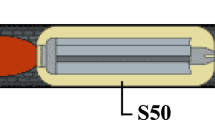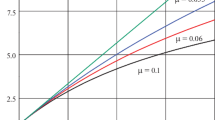Abstract
This paper deals with a trajectory optimization problem for a three-stage launcher with the aim to minimize the consumption of propellant needed to steer the launcher from the Earth to the GEO (geostationary orbit). Here we use a global optimization procedure based on Hamilton-Jacobi-Bellman approach and consider a complete model including the transfer from a GTO (geostationary transfer orbit) to the GEO. This model leads to an optimal control problem involving also some optimization parameters that appear in the flight phases. First, an adequate formulation of the control problem is introduced. Then, we discuss some theoretical results related to the value function and to the reconstruction of an optimal trajectory. Numerical simulations are given to show the relevance of the global optimization approach. This work has been undertaken in the frame of CNES Launchers’ Research and Technology program.
Access this chapter
Tax calculation will be finalised at checkout
Purchases are for personal use only
Similar content being viewed by others
References
“ROC-HJ” software, a parallel d-dimensional c++ solver for reachability and optimal control using Hamilton-Jacobi equations. http://uma.ensta-paristech.fr/soft/ROC-HJ
Altarovici, A., Bokanowski, O., Zidani H.: A general Hamilton-Jacobi framework for non-linear state-constrained control problems. ESAIM: Cont., Optim. Calc. Var. 19(337–357), 2013 (2012 electronic)
Assellaou, M., Bokanowski, O., Desilles, A., Zidani, H.: HJB approach for state constrained control problems with maximum cost. Preprint (2016)
Aubin, J.-P., Cellina, A.: Differential inclusions. Comprehensive Studies in Mathematics, vol. 264. Springer, Berlin, Heidelberg, New York, Tokyo (1984)
Bardi, M., Capuzzo-Dolcetta, I.: Optimal Control and viscosity solutions of Hamilton-Jacobi-Bellman Equations. Birkhäuser Boston (1997)
Bellman, R.: Dynamic Programming. Princeton University Press, Princeton (1961)
Bérend, N., Bonnans, J.F., Laurent-Varin, J., Haddou, M., Talbot, C.: An interior point approach to trajectory optimization. J. Guid. Cont. Dyn. 30(5), 1228–1238 (2005)
Betts, J.T.: Survey of numerical methods for trajectory optimization. J. Guid. Control Dyn. 21(2), 193–207 (1998)
Betts, J.T.: Practical Methods for Optimal Control Using Nonlinear Programming. Society for Industrial and Applied Mathematics, Philadelphia (2001)
Bokanowski, O., Bourgeois, E., Desilles, A., Zidani, H.: HJB approach for a multi-boost launcher trajectory optimization problem. In: IFAC Proceedings, 20th IFAC Symposium on Automatic Control in Aerospace (ACA), Vol. 49(17), pp. 456–461 (2016)
Bokanowski, O., Bourgeois, E., Desilles, A., Zidani, H.: Payload optimization for multi-stage launchers using hjb approach and application to a sso mission. In: IFAC Proceedings, 20th IFAC World Congress, Vol. 50(1), pp. 2904–2910 (2017)
Bokanowski, O., Briani, A., Zidani, H.: Minimum time control problems for non-autonomous differential equations. Syst. Cont. Lett. 58(10–11), 742–746 (2009)
Bokanowski, O., Cristiani, E., Zidani, H.: An efficient data structure and accurate scheme to solve front propagation problems. J. Sci. Comput. 42(10), 251–273 (2010)
Bokanowski, O., Forcadel, N., Zidani, H.: \({L}^1\)-error estimate for numerical approximations of Hamilton-Jacobi-Bellman equations in dimension 1. Math. Comput. 79, 1395–1426 (2010)
Bokanowski, O., Forcadel, N., Zidani, H.: Reachability and minimal times for state constrained nonlinear problems without any controllability assumption. SIAM J. Control Optim. 48(7), 4292–4316 (2010)
Bonnans, F., Martinon, P., Trélat, E.: Singular arcs in the generalized Goddard’s problem. J. Optim. Theory Appl. 139(2), 439–461 (2008)
Bonnard, B., Faubourg, L., Trélat, E.: Optimal control of the atmospheric arc of a space shuttle and numerical simulations with multiple shooting method. Math. Models Methods Appl. Sci. 15(1), 109–140 (2005)
Calise, A.J., Gath, P.F.: Optimization of launch vehicle ascent trajectories with path constraints and coast arcs. J. Guid., Control, Dyn. 24(2), 296–304 (2001)
Crandall, M.G., Evans, L.C., Lions, P.-L.: Some properties of viscosity solutions of Hamilton-Jacobi equations. Trans. Amer. Math. Soc 282(2), 487–502 (1984)
Crandall, M.G., Lions, P.-L.: Viscosity solutions of Hamilton Jacobi equations. Bull. Am. Math. Soc. 277(1), 1–42 (1983)
Crandall, M.G., Lions, P.-L.: Two approximations of solutions of Hamilton-Jacobi equations. Math. Comput. 43(167), 1–19 (1984)
Falcone, M., Ferretti, R.: Semi-Lagrangian Approximation Schemes for Linear and Hamilton-Jacobi Equations. SIAM - Society for Industrial and Applied Mathematics, Philadelphia (2014)
Forcadel, Nicolas., Rao, Zhiping, Zidani, Hasnaa: State-constrained optimal control problems of impulsive differential equations. Appl. Math. Optim. 68(1), 1–19 (2013)
Goddard, R.H.: A method of reaching extreme altitudes. Smithson. Miscellaneous Coll. 71(4), (1919)
Jiang, G.-S., Peng, D.: Weighted ENO schemes for Hamilton-Jacobi equations. SIAM J. Sci. Comput. 21(6), 2126–2143 (2000)
Johnson, W.: Contents and commentary on william moore’s a treatise on the motion of rockets and an essay on naval gunnery. Int. J. Impact Eng 16(3), 499–521 (1995)
Laurent-Varin, J.: Optimal Ascent and Reentry of Reusable Rockets. PhD thesis, Ecole Polytechnique, 2005. Supported by CNES and ONERA
Lu, P., Sun, H., Tsai, B.: Closed-loop endoatmospheric ascent guidance. J. Guid., Control, Dyn. 26(2), 283–294 (2003)
Margellos, K., Lygeros, J.: Hamilton-Jacobi Formulation for Reach-Avoid Differential Games. IEEE Trans. Autom. Control 56(8), 1849–1861 (2011)
Martinon, P., Bonnans, J.F., Laurent-Varin, J., Trélat, E.: Numerical study of optimal trajectories with singular arcs for an Ariane 5 launcher. J. Guid. Control Dyn. 32(1), 51–55 (2009)
Mooij, E.: The Motion of a Vehicle in a Planetary Atmosphere. Technical report, TU Delft (1994)
Oberle, H.J.: Numerical computation of singular control functions in trajectory optimization problems. J. Guid. Control Dyn. 13, 153–159 (1990)
Osher, S., Shu, C.-W.: High essentially nonoscillatory schemes for Hamilton-Jacobi equations. SIAM J. Numer. Anal. 28(4), 907–922 (1991)
Pesch, H.J.: Real-time computation of feedback controls for constrained optimal control problems, Part 2: a correction method based on multiple shooting. Optim. Control, Appl. Methods 10(2), 147–171 (1989)
Pesch, H.J.: A practical guide to the solution of real-life optimal control problems. Control Cybern. 23(1–2), 7–60 (1994)
Rowland, J.D.L., Vinter, R.B.: Construction of optimal feedback controls. Syst. Control Lett. 16(5), 357–367 (1991)
Vinter, R.: Optimal Control. Modern Birkhäuser Classics. Birkhäuser Boston, Inc., Boston, MA (2010). (Paperback reprint of the 2000 edition)
Zhang, L., Lu, P.: Fixed-point algorithms for optimal ascent trajectories of launch vehicles. Eng. Optim. 40(4), 361–381 (2008)
Zhu, J., Trélat, E., Cerf, M.: Minimum time control of the rocket attitude reorientation associated with orbit dynamics. SIAM J. Control Optim. 54(1), 391–422 (2016)
Zondervan, K.P. Bauer, T.P., Betts, J.T., Huffman, W.P.: Solving the optimal control problem using a nonlinear programming technique. part 3: Optimal shuttle reentry trajectories. Proceedings of the AIAA/AAS Astrodynamics conference, Seattle (1984)
Acknowledgements
We thank the anonymous referees for their useful comments. This work is partially supported by Centre National d’Études Spatiales (CNES), under the grant RT-CR-430-1304-CNES. It is also supported by public grant overseen by the French National Research Agency (ANR), through the “iCODE Institute project” funded by the IDEX Paris-Saclay, ANR-11-IDEX-0003-02.
Author information
Authors and Affiliations
Corresponding author
Editor information
Editors and Affiliations
Appendices
Appendix 1 Definition of Orbital Parameters
For the phase 3 of the flight sequence there are two kinds of orbital maneuvers:
-
Injection on a GTO orbit
-
Orbital transfer from GTO to the GEO.
We define here all necessary parameters to describe these maneuvers.
1.1 Appendix 1.1 GTO Injection Parameters
A GTO orbit is represented on Fig. 13. We denote A and P the perigee and apogee centers of the orbit respectively. The line of nodes is the line of intersection of the orbital plane with the equatorial plane of the Earth. It’s extremal points are respectively ascending (NA) and descending (ND) nodes of the orbit. A GTO orbit can be fully defined with the following set of parameters \((r_a,r_p,\Upsilon ,\omega ,\mathbf {i})\), where:
-
\(r_a\) and \(r_p\) are respectively the distances from the center of the Earth of the perigee and the apogee of the orbit
-
\( \Upsilon \) is the polar position of the perigee P, measured positively from the ascending node NA.
-
\(\mathbf{{i}}\) is the inclination of the orbital plane with respect to the equatorial plane of the Earth.
On can deduce from these parameters the semi-major axis a, and the eccentricity e by:
A point Q on the orbit is defined by its angular position \( \varsigma \), called true anomaly (see Fig. 13). Let \(c_0=3.986\cdot 10^{14}\,m^3\,s^{-2}\) be the Earth’s gravitational constant. Given orbital parameters defined below and the true anomaly of a point Q on the orbit, one can deduce the corresponding orbit radius \(r_Q(\eta )\) and orbit velocity \(v_Q(\varsigma )\) as follows:
In this study we consider a family of GTOs with a fixed perigee altitude \(r_p^0\) and that intersect a given GEO. Recall that a GEO is a circular orbit in the equatorial plane of the Earth. It is fully defined by the data of its radius \(r_{GEO}\). If a GTO intersects a GEO of radius \(r_{GEO}\), this fixes the orbit radius of its ascending node NA. Note that by definition (see Fig. 13) the true anomaly of the point NA is \(- \Upsilon \). Then we have the following condition:
from which we deduce the apogee altitude:
So, if we fix the perigee altitude \(r_p\) and the GEO radius \(r_{GEO}\) the parameter \(r_a\) is also fixed. Then the set of considered GTO orbits is defined by the inclination \(\mathbf {i}\in [i_{min},i_{max}]\) The perigee orientation \( \Upsilon \) is fixed. For each GTO orbit we define a segment of injection \(\mathcal {C}_\mathbf{{i}}\) as a neighborhood of the perigee.
1.2 Appendix 1.2 Orbital Transfer Parameters
In our study, we assume that the GTO- GEO orbital transfer is performed through an impulse boost (to change the velocity’s modulus and direction). The amount of propellant required for the orbital transfer is determined by the choice of the GTO via Tsiolkovsky’s formula. Let \(\overrightarrow{V}_{GTO}\) be the speed at the ascending node of the GTO, and \( \mathbf {V}_{GEO}\) be the desired GEO speed. Then the differential gear to provide the vehicle is the vector difference:
with the modulus:
Note that the speed \(V _{GTO}\) can be expressed using (37) for the ascending node:
The formula Tsiolkovsky connects the differential speed to provide the required fuel mass
where \(m_{init}\) and \(m_{final}\) are respectively the launcher’s masses before and after the operation. Thus one can calculate the weight of propellant required to the GTO-GEO orbital transfer in a single impulse, knowing the speed at the height of the GTO and its inclination with respect to the GEO.
Appendix 2 Numerical Data Used for Simulations
Table 5 gives the list of numerical constants and data functions describing the dynamical properties of the launcher and the atmospheric model used in our computations. Furthermore, Fig. 14 represents the air density (and sound speed) models, the thrust (for boosters and stage E1), and drag function. All these data were provided by CNES (Table 6).
Rights and permissions
Copyright information
© 2021 Springer Nature Switzerland AG
About this paper
Cite this paper
Bokanowski, O., Bourgeois, E., Désilles, A., Zidani, H. (2021). Global Optimization Approach for the Ascent Problem of Multi-stage Launchers. In: Bock, H.G., Jäger, W., Kostina, E., Phu, H.X. (eds) Modeling, Simulation and Optimization of Complex Processes HPSC 2018. Springer, Cham. https://doi.org/10.1007/978-3-030-55240-4_1
Download citation
DOI: https://doi.org/10.1007/978-3-030-55240-4_1
Published:
Publisher Name: Springer, Cham
Print ISBN: 978-3-030-55239-8
Online ISBN: 978-3-030-55240-4
eBook Packages: Mathematics and StatisticsMathematics and Statistics (R0)






